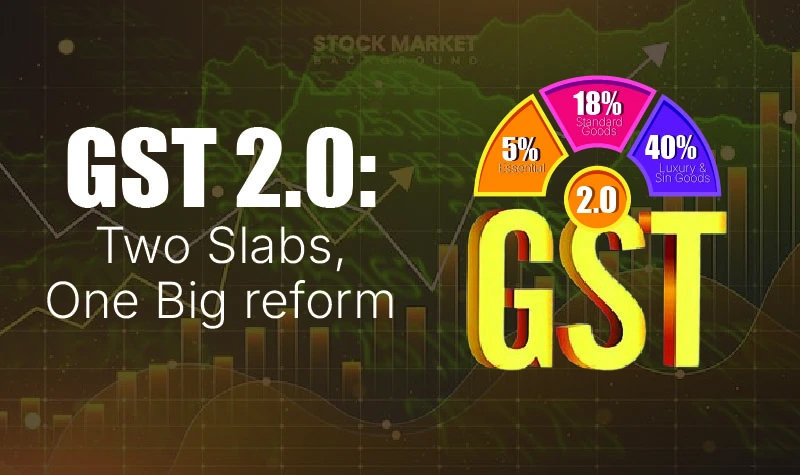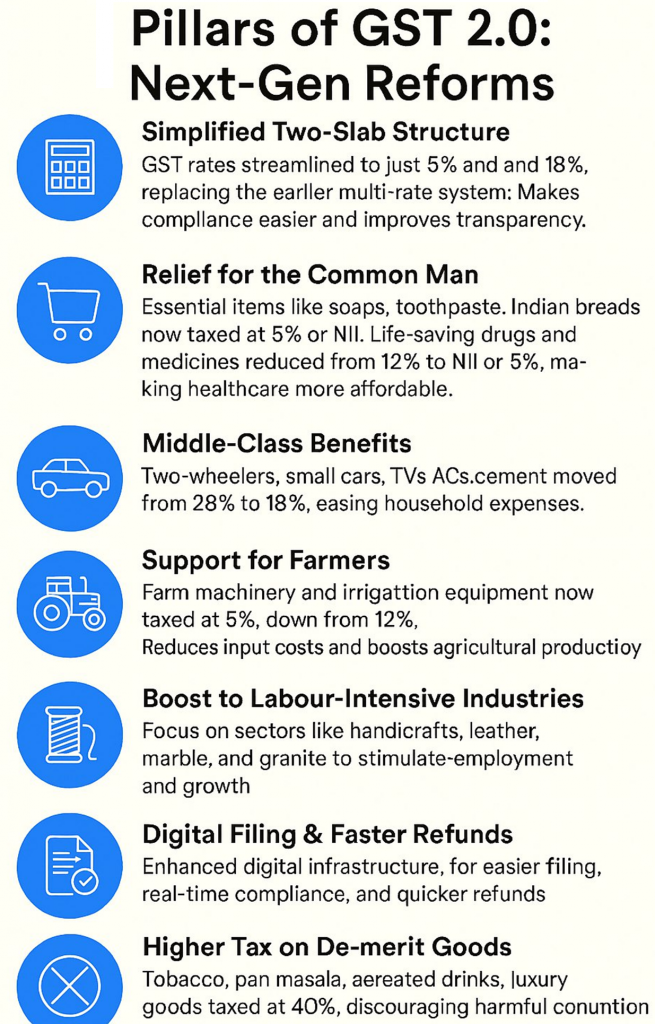Context:
India has undertaken one of the most significant reforms in its indirect taxation system since the launch of the Goods and Services Tax (GST) in 2017. Popularly described as GST 2.0, the reform package that came into effect on 22 September 2025 involves a broad restructuring of GST slabs, rationalisation of rates, and streamlining of compliance procedures.
- Termed by the government as the “GST Bachat Utsav”, the new measures are aimed at simplifying the tax structure, boosting consumption, reduce the problem of inverted duty structures, and leave more disposable income in the hands of citizens. By cutting rates on more than 375 items, the government expects household consumption to expand, which in turn can attract more private investment and help compensate for the revenue loss due to the tax cuts.
Evolution of GST:
- The GST was introduced in July 2017, subsuming 17 different indirect taxes and 13 cesses under a unified consumption-based tax. While the reform was hailed as a major step towards creating “One Nation, One Tax, One Market”, in practice, it became complex due to multiple rate slabs, frequent exemptions, and disputes over classification of goods and services.
- Over the last eight years, more than a dozen rounds of rate revisions have taken place. However, GST 2.0 is the most ambitious restructuring, as it moves away from a complicated four-slab system to a simplified two-slab design, with special rates for precious stones and demerit goods.
Key Features of GST 2.0:
1. Simplified Rate Structure
Earlier, GST operated under four major slabs: 5%, 12%, 18%, and 28%, along with several special rates. GST 2.0 reduces this to a two-tier structure:
-
- Merit rate of 5% – covering 516 goods and services, largely essential commodities like food items, agricultural machinery, and some medical devices.
- Standard rate of 18% – covering 640 categories, mainly industrial products such as chemicals, paints, automobile parts, boilers, small cars, and two-wheelers.
- Merit rate of 5% – covering 516 goods and services, largely essential commodities like food items, agricultural machinery, and some medical devices.
2. Special Rates
-
- 0.25% – rough diamonds, semi-precious stones.
- 1.5% – cut and polished diamonds.
- 3% – precious metals like gold, silver, and pearls.
- 40% (demerit rate) – luxury and sin goods such as pan masala, aerated drinks, large cars, yachts, and personal aircraft.
- Tobacco products – remain under the earlier system of 28% GST + compensation cess, with an additional levy expected soon.
- 0.25% – rough diamonds, semi-precious stones.
3. Removal of 12% Slab
The 12% slab has been abolished for most items. Only bricks remain under this category, governed by a special composition scheme (6% without input tax credit and 12% with input tax credit).
4. Service Sector Reforms
-
- Health and life insurance for individuals – exempted from GST (earlier taxed at 18%).
- Hotels with tariff up to ₹7,500/day – taxed at 5% without input tax credit (earlier 12% with ITC).
- Salons, spas, and wellness services – GST reduced to 5% from 18%.
- Health and life insurance for individuals – exempted from GST (earlier taxed at 18%).
Economic Rationale Behind GST 2.0:
1. Boosting Household Consumption
The government expects that lower GST rates will increase disposable income, which in turn will spur demand for goods and services. This rise in consumption is projected to generate higher investment, job creation, and ultimately, greater tax revenues, offsetting the immediate revenue loss from rate cuts on more than 375 items.
2. Correcting the Inverted Duty Structure (IDS)
One of the persistent problems under the earlier GST system was the inverted duty structure, where inputs attracted a higher tax rate than the final product. This caused working capital blockages as businesses struggled to claim refunds.
-
- Example: Steel attracts 18% GST while bicycles are taxed at only 5%.
- GST 2.0 has attempted to reduce such mismatches by aligning inputs and outputs within the same slab.
- Example: Steel attracts 18% GST while bicycles are taxed at only 5%.
3. Simplification and Transparency
By merging four major slabs into two, GST 2.0 reduces the scope for classification disputes. Earlier controversies like whether roti and parotta should attract different rates are now less likely, as similar goods have been placed under uniform categories.
Passing Benefits to Consumers:
- To ensure that companies pass on tax savings to consumers, the Ministry of Finance has directed field officers to compile monthly reports for six months tracking pre- and post-GST prices of 54 common items. These include food products (milk, butter, dry fruits, biscuits, chocolates), personal care items (toothpaste, shampoo, shaving cream), and educational supplies (notebooks, pencils, crayons).
- While there is no strict anti-profiteering law currently in place, the government hopes that regular monitoring will help keep prices in check and ensure household budgets benefit directly from GST cuts.
Implementation and Compliance Reforms:
1. Registration
· The registration process is being redesigned to be more technology-driven and time-bound, reducing delays and paperwork especially for small businesses and start-ups.
2. Return Filing
· GST 2.0 will introduce pre-filled returns, cutting down on manual errors, mismatches, and the compliance burden on businesses.
3. Refund Mechanism
· Refunds, especially for exporters and businesses facing inverted duty structure, will be automated for faster clearance. The GST Council has also approved amendments to Section 54(6) of the CGST Act, 2017, which will allow 90% provisional refunds in IDS cases, similar to the mechanism already available for zero-rated exports.
· Pending formal amendments, the Central Board of Indirect Taxes and Customs (CBIC) has been directed to issue instructions for granting provisional refunds from November 1, 2025 (possibly advanced to October).
Challenges Ahead:
1. Revenue Concerns: Rate cuts across more than 375 items will create short-term revenue losses for both the Centre and States. The government is relying heavily on a consumption-driven recovery to bridge this gap.
2. Persistent Inverted Duty Issues: Despite efforts, IDS has not been eliminated entirely. Sectors such as bicycles, tractors, fertilisers, textiles, and corrugated boxes continue to face mismatches between input and output tax rates, leading to capital blockage.
3. Enforcement Gaps: India lacks a strong legal mechanism to ensure that companies pass on tax benefits to consumers. The reliance on monitoring alone may not be sufficient to prevent profiteering.
4. State Finances: States, already dependent on GST compensation, may face stress if revenues dip further. Ensuring cooperative federalism in GST implementation remains a critical challenge.
Way Forward:
1. Tighten Anti-Profiteering Measures – Introduce a stronger legal framework to ensure tax cuts are fully reflected in retail prices.
2. Address Residual IDS Issues – Focus on sectors still suffering from input-output mismatches.
3. Digital Monitoring of Compliance – Use real-time data analytics for tracking registration, filing, and refunds.
4. Periodic Slab Reviews – Continue assessing the slab structure to balance ease of doing business with revenue requirements.
5. Strengthen State Finances – Create mechanisms to stabilise state revenues while ensuring GST remains attractive for businesses.
6. Build Trust-Based Compliance – Promote voluntary compliance through simpler processes, reduced paperwork, and predictable policies.
Conclusion:
GST 2.0 is a landmark reform in India’s taxation journey. By simplifying slabs, rationalising rates, and improving compliance processes, it addresses many of the pain points that plagued the first phase of GST. For consumers, it promises price relief and better household budgeting. For businesses, it brings clarity and ease of operations.
| UPSC/PSC Main Question: GST 2.0 marks a major departure from India’s earlier multi-slab system by moving towards simplification and rationalisation.” Critically analyse the economic rationale behind this reform and discuss its possible implications. |








